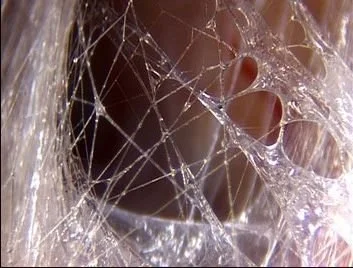What is Fascia and Why You Should be Training It
We all know about muscles and bones, the building blocks of our body. But what about the hidden hero holding it all together? Enter fascia, the often-overlooked connective tissue that plays a crucial role in our overall health and well-being.
Fascia: The Body’s Essential Web
Imagine your body as a building. Muscles and bones are the bricks and mortar, providing structure and support. But what holds everything together, creating a unified system? That's fascia. Fascia is a web of collagen and elastic connective tissue that surrounds and permeates every part of your body, from head to toe, from muscles to organs.
It’s our body’s continuous bodysuit, wrapping and connecting everything, ensuring smooth movement and proper function. When parts of the fascia system become restricted, however, the soft tissue can ‘pull’ on bones and muscles, creating postural changes in the body. It explains why our knees can turn inwards, creating knee valgus, or why our shoulders round; the fascia system is governed by tensegrity principles, and when one part of a fascial line is lengthened, the antagonist line is shortened. This is the body’s clever way of keeping us upright, stable and with our eyes on the horizon line. It simply adapts to the stimulus or stresses we place on the body so we don’t topple over when we are misaligned.
Although helpful in keeping us upright, this adaption isn’t always ideal. Long-term postural changes caused by restrictions in the fascia can pull our bodies out of alignment, leading to pain, decreased mobility and even limitations in our athletic performance.
The Fitness Industry's Blind Spot
For decades, the fitness industry has focused heavily on isolated muscle training – think bicep curls and hip thrusts. While building muscle strength is important, this approach often neglects a crucial component of whole-body structural integrity: fascia. Tom Myers, a renowned expert in the field highlights this shortcoming: "The current fitness paradigm largely ignores fascia, which is a major oversight. When fascia is restricted and dehydrated, it can lead to limitations in mobility, pain and dysfunctional movement patterns."
Along with lifestyle habits, such as long periods of sitting, stress and general bad posture, suboptimal movement is a major cause of ill fascial health. Exercises that keep us predominantly in the linear plane (think squats, deadlifts, shoulder press) often neglect the body’s natural way of moving. And as we covered earlier, fascia needs optimal ‘glide’ and thus movement in the multidimensional plane to ensure it remains hydrated and healthy.
The Power of Fascia
Fascia is much more than just passive connective tissue. It plays a vital role in several key functions, since it connects every cell in the body. Fascia is our interconnected highway, a complex communication system that flows energy through the body.
Now imagine we have adhesions or chemical build-up in our fascia. What happens? Much like when you have a kink in your hosepipe and the water cannot flow through, trauma in the fascia inhibits this flow of communication that our cells need to maintain optimal function.
Maintaining Posture and Stability: Fascia provides structural support, helping maintain proper posture and alignment.
Movement Efficiency: Healthy, hydrated fascia allows for smooth gliding of muscles and joints, leading to efficient and pain-free movement.
Cellular Communication: Fascia acts as a communication network, transmitting signals between cells and tissues throughout the body.
Elasticity, Plasticity, and Viscosity: Fascia possesses unique properties like elasticity (the ability to return to its original shape after stretching), plasticity (the ability to adapt to changes in stress and strain), and viscosity (resistance to flow). These properties are essential for optimal movement and injury prevention.
But what truly sets fascia apart is its connection to cell stasis. This theory suggests that restricted and dehydrated fascia can lead to misaligned cells, disrupting the flow of information and nutrients. This dysfunction can contribute to various health issues.
How To Support Your Fascia
Myofascia Release
Hydration is Key
And by hydration, we don’t mean chugging gallons of water. While staying well-hydrated is important overall, directly hydrating fascia through water intake isn't the answer.
When fascia becomes dehydrated, the tissue fibres become dense and sticky. This causes a lack of smooth glide in the layered sheets of the tissue, resulting in adhesions (trigger points) and a lack of mobility in that area.
Myofascial release brings hydration back into the soft tissues. It increases the distance between the collagen fibres, allowing for better glide, reduced compression and an increase of blood flow to that area, promoting healing and easing trigger points.
2. Optimal Movement
Once the fascial adhesions have been released, you can essentially remodel your fascia through optimal movement. Think of it as a circuit board: adhesions act like short circuits, disrupting the flow of information throughout the body. Fascia release techniques clear these blockages. Through optimal movement, you're essentially re-wiring the circuit board, creating new pathways for communication and allowing the body to function more efficiently.
This is a crucial step, and overlooking it is often the reason why people end up with the same reoccurring issues and injuries after multiple visits to the chiropractor or physio. They may have released a trigger point or had their spine realigned, but if they go back to their usual exercise routine (or lifestyle habits), the fascia will adopt the same patterns and adhesions as before.
By incorporating exercises that engage various planes of motion, we can train our fascia to be more adaptable and resilient. This not only improves mobility and reduces pain, but also translates into better performance in activities that require agility and coordination. Activities like barefoot running and explosive jumping can boost the fascia’s elastic recoil, a property of fascia that helps us absorb and generate force efficiently.
3. Reducing Chemical Load
Our modern world exposes us to numerous chemicals, some of which may have hidden impacts on our fascia. One concern is glyphosate, the active ingredient in common herbicides. Glyphosate is structurally similar to one of the amino acids that make up the collagen of the fascia: glycine. Glyphosate mimics glycine in the body, disrupting the collagen structure in the body – and we know what happens when the intricate nature of the fascia is negatively manipulated. Minimising your exposure to glyphosate means buying organic fruit and vegetables. Get to know where your produce is coming from – speak to local growers about how they’re producing it, or, of course, you can always grow your own.
The same can also be said for substances such as heavy metals and endocrine disruptors. BPA (Bisphenol-A), found in some plastics, can mimic estrogen and is linked to changes in collagen metabolism and increased inflammation, which could indirectly affect fascia. Similarly, Phthalates, widely used in plastics and personal care products, can interfere with hormone balance and have been loosely associated with changes in connective tissue density. Some pesticides also act as endocrine disruptors, potentially affecting the hormonal processes involved in fascia health.
4. Optimising Circadian Rhythms
This is where it gets interesting. But first, we need to take a brief detour into quantum biology.
Quantum biology examines how the sometimes strange principles of the quantum world might operate in living systems. One researcher, Dr. Gerald Pollack theorises that water near our cells can form a structured, organised state (called EZ water). This EZ water acts like a tiny battery within our fascia, storing energy.
One way Pollack suggests we might "charge" these fascial batteries is through infrared light and sunlight is a prime source of infrared. Sun exposure could play a role in powering up processes in our fascia.
How does this tie into circadian rhythms? Those internal clocks governing our sleep/wake cycles are heavily influenced by light. Optimal circadian rhythms are linked to better overall health, including potentially improved fascial function and cell communication.
Practical Takeaways
While the science continues to unfold, here's what we know helps both circadian rhythms and fascia health:
Prioritise Sunlight & Natural Light: Get your natural light exposure daily, especially in the morning. This helps set your circadian clock and might have added benefits according to Pollack's work.
Optimise Sleep Environment: Make your bedroom dark, cool and quiet for optimal sleep and circadian health. And remember to always block blue light after sunset.
Resetting Your Body: It's All Connected
This interconnected approach to movement and fascia health is the foundation of my coaching program, The Reset Program. The program takes you through a journey of breathwork, fascia release techniques and biomechanically sound movement practices.
Breathwork helps optimise oxygen intake and release, which is crucial for nutrient delivery and cellular function.
Fascia release techniques target specific areas, improving flexibility, reducing pain, and restoring optimal mobility.
Biomechanical movement exercises train your body as a whole unit, honouring its natural design and promoting efficient, pain-free movement.
By combining these elements in The Reset Program, we can address the limitations of traditional training methods and work towards a body that is:
Strong and resilient: Increased mobility and fascia health create a foundation for injury prevention and improved performance.
Pain-free and mobile: Reduced restrictions and adhesions lead to a body that moves freely and comfortably.
Full of vitality: Improved flow and cellular health can enhance energy levels and overall well-being.



